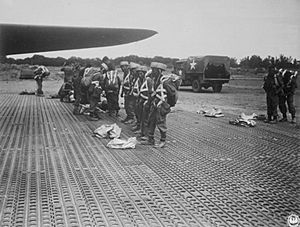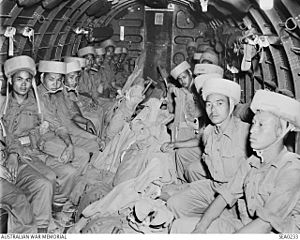Battle of Elephant Point facts for kids
Quick facts for kids Battle of Elephant Point |
|||||||
|---|---|---|---|---|---|---|---|
| Part of Operation Dracula | |||||||
 Gurkha paratroopers check their equipment before being dropped on a series of strategic points around Rangoon |
|||||||
|
|||||||
| Belligerents | |||||||
| Commanders and leaders | |||||||
| Strength | |||||||
| Composite Parachute Battalion | Japanese forces | ||||||
| Casualties and losses | |||||||
| Disputed (See Notes) | Disputed (See Notes) | ||||||
| First major airborne operation by 44th Indian Airborne Division | |||||||
The Battle of Elephant Point was an important military action during World War II. It happened on May 1, 1945, near Rangoon, the capital city of Burma. This battle was special because it was an airborne operation. This means soldiers jumped from planes using parachutes.
A special group of Gurkha paratroopers carried out this mission. Their goal was to capture a Japanese artillery battery at Elephant Point. This location was key because it controlled the entrance to the Rangoon River. Taking it was necessary for a larger plan to recapture Rangoon.
Contents
Why This Battle Was Important
In March 1945, Allied leaders met to plan their next moves in South East Asia. They wanted to take back Burma, Malaya, and Singapore from Japan. Capturing Rangoon was a big step in this plan. It had to be done quickly, before the heavy monsoon rains started in June. The rains would make it very hard to move troops and supplies over land.
At first, the plan was for ground troops to march to Rangoon. But commanders worried about strong Japanese resistance. They also worried about their supply lines becoming too long. So, they decided to add a joint attack from the sea and the air. This new plan was called Operation Dracula.
Planning the Attack
Operation Dracula involved both naval forces and ground troops. The main goal was to sail up the Rangoon River. But there was a big problem: the river was full of mines. These mines were placed by both the Japanese and the British earlier in the war. Before ships could enter, the river had to be cleared.
To clear the river, the coastal defenses had to be destroyed first. A major concern was a Japanese artillery battery at Elephant Point. This battery could fire on any ships trying to enter the river. Because of the area's geography and bad weather, it was decided that an air attack was the best way to deal with it.
So, a day before the main sea attack, a parachute battalion would jump near Elephant Point. Their mission was to attack and destroy the battery.
The job was given to the 44th Indian Airborne Division. However, this division was being reorganized. Many of its soldiers and officers were not available. So, a special "composite" battalion was formed. It was made up of soldiers from two Gurkha parachute battalions.
This new battalion trained throughout April. They practiced for the mission. On April 29, they flew to Akyab, a place on the Burmese coast. From there, they would be flown to Elephant Point by 40 C-47 Skytrain transport planes.
The Battle at Elephant Point
Early on May 1, 1945, the Gurkha paratroopers took off in their planes. At 5:45 AM, they jumped over their drop zone near Elephant Point. There were only a few injuries during the jump. They didn't face any Japanese resistance right away.
After gathering their gear, the soldiers moved towards the artillery battery. They stopped about 3,000 yards away. This was to allow American bombers to attack the battery first. But something went wrong. Even though the soldiers wore bright yellow panels to identify themselves, one of their companies was accidentally bombed by the American planes. This caused some injuries. After this, all further bombing runs were stopped.
Despite the accident and heavy rain, the battalion kept going. They reached Elephant Point at 4:00 PM. Fierce fighting began. The Gurkhas used flame-throwers against Japanese bunkers. About 40 Japanese soldiers and gunners were killed. The Gurkha battalion also had some casualties.
After securing the battery, the soldiers dug in. They waited for a relief force to arrive. This force landed nearby later that day. During the night, high tides flooded some of their trenches, forcing them to move to higher ground.
By dawn on May 2, the Gurkhas had cleared more Japanese bunkers. They watched as minesweepers cleared the Rangoon River. This made way for the main invasion force coming by sea.
Aftermath
Operation Dracula was a big success. It turned out that Japanese forces had already left Rangoon a few days before the main sea landing. So, the 36th Indian Infantry Brigade was able to enter the city without any fighting.
On May 3, the composite Gurkha battalion moved to Sadainghmut. Two days later, they went to Rangoon. There, they helped stop looting and searched for any remaining Japanese soldiers. On May 16, they left Rangoon by ship and returned to India. They rejoined their division, the 44th Indian Airborne Division. The Battle of Elephant Point was the division's first major airborne operation.
Images for kids



